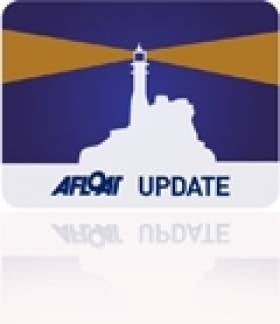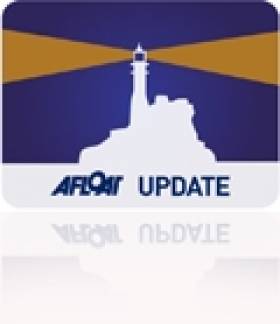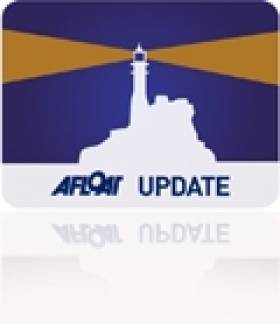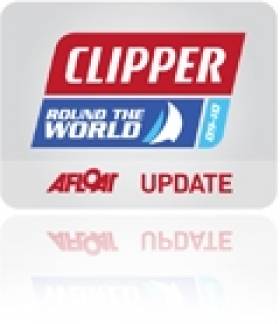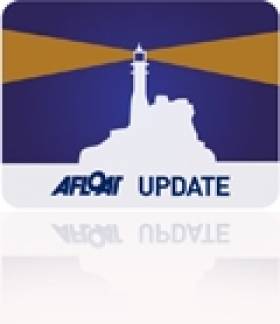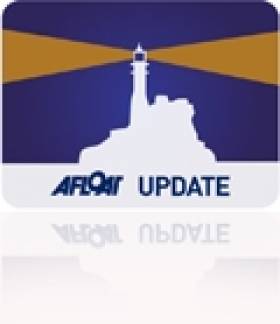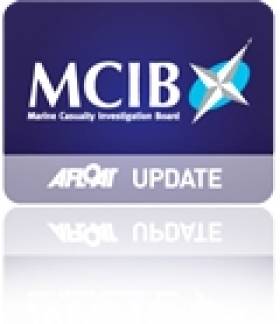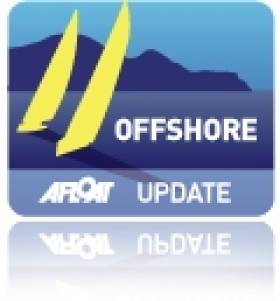Displaying items by tag: Fastnet Race
Fastnet Small Boats Finish the Race, Just 14 Still at Sea
#fastnet – Of the record breaking-sized fleet of 337 boats that set sail from the Solent last Sunday at the start of the Rolex Fastnet Race, the majority has now finished in Plymouth. Just 14 boats are still racing with the classic Fife gaff yawl, Duet, bringing up the rear, having only broken the '200 miles-to-go' barrier earlier this morning.
One of the latest arrivals this morning has been the Sigma 33c, Elmarleen, sailed by Will Sayer and Tim Paull. Significantly Sayer won the Two Handed class in the Rolex Fastnet Race two years ago aboard Elmarleen.
He had been hoping to repeat his success this year. Unfortunately conditions conspired against Elmarleen, as Sayer observes: "We have come in about six hours ahead of last time but this time we haven't done half as well. This year it was neither a big boat nor a little boat race - Class 2 and 3 have dominated."
The smallest, slowest boats in the fleet had to endure a very light first 48 hours. Sayer adds that they were unlucky after passing Portland Bill, when the bulk of the fleet managed to duck into Lyme Bay to get out of the worst of the foul tide, while Elmarleen had remained offshore.
While the Maxis were being becalmed off the Scilly Isles on the way back from the Fastnet Rock, the smaller boats suffered the same fate only with the return journey across the Celtic Sea still ahead of them. Sayer reckons it took them a whole day just to crawl from Land's End to the north of the Scillies. "We were lolloping around doing 2-3 knots, knowing that everyone else was in better wind ahead - it was very painful."
Finally the breeze filled in for Elmarleen on Tuesday afternoon. "It was fantastic to finally get going, but watching our average speed it was horrifying. At one point we were lying 255th and I was hoping to be in the top 5-10."
Thankfully from here, Sayer believes that they could not have sailed a quicker Rolex Fastnet Race, white sail reaching up to the Rock and back again and finally able to hoist the spinnaker from Bishop Rock on.
For the final run from Bishop Rock into the finish Elmarleen was flying. "Last night we were surfing at up to 11 knots - two handed in the dark. I am absolutely shattered, even though we got some sleep yesterday during the day knowing that we'd be putting up the big kite once we got to the Lizard."
Sayer was delighted to hear that the Rolex Fastnet Race overall had been won for the first time ever by a Two Handed crew, in Pascal and Alexis Loisin's Night And Day. "It's fantastic news for them."
Two-Handed racing continues to grow in the UK. This year there were 45 boats entered in the doublehanded class, compared to 36 last year, and this excludes the seven doublehanded IMOCA 60s and the nine Figaros.
It appears this is one area where British crews are holding their own. While overall under IRC there are French boats among the top 10 finishers (with Britain and Belgium on one apiece), in the Two Handed class, only four of the top 10 were French, with three British, two Dutch and one Spanish.
Figaro entente cordiale
This year the doublehanded Figaros were competing in their own class. This was won by the Anglo-French pairing of professional French sailor Charlie Dalin and Nikki Curwen, the latter of the Artemis Offshore Academy, enjoying her first proper Figaro race.
"It was really intense, very different from what I am used to - I think 1.8 miles was the furthest we got away from another boat in the class," enthused Curwen. "We could see someone the whole way round so we were constantly fighting for it.
"We had a much faster run to the Rock than most of the other boats. Then we had a tight reach in 25-26 knots all the way back from the traffic separation scheme (TSS) off the Scillies, with the big kite up. It was touch and go, edgy, with everything stacked up and pilot on and just played the sails."
While the Figaro turn-out was relatively small compared to the fleet sizes typically seen during Figaro races in France, there were some key players competing. In addition to the strong turn-out from the Artemis Offshore Academy, the line-up included Xavier Macaire, who finished second in this year's Solitaire du Figaro.
While Macaire and co-skipper Yves Ravot led for the first part of the race, Dalin and Curwen pulled ahead coming into the TSS to the south of the Fastnet Rock. From there on, the two boats match- raced around the remainder of the course with Dalin and Curwen always just a nose in front. They arrived into Plymouth yesterday morning, just 5 minutes 28 seconds ahead of the Artemis Offshore Academy's Ed Hill sailing with Figaro Race Director and former Mini Transat winner, Gilles Chiorri, with Ravot and Macaire third.
Curwen hopes victory in the Rolex Fastnet Race will help her raise the remaining funds to enable her to compete in the Mini Transat in October. In this she intends to follow in the footsteps of her father Simon, although she will have quite a job to keep up with her father's record: Simon Curwen finished second on the 2001 Mini Transat and is the highest ever British finisher.
Irish Boats Well Placed at Start of Fastnet Race
#fastnet – Up to a dozen boats of Irish interest are among those bunched up this evening in Poole Bay as the Rolex Fastnet Race 2013 set sail from Cowes this afternoon. Top performer this evening is Irish champion yacht, Anthony O'Leary's Antix lying in sixth overall (and third on IRC one) but with over 560 miles still to sail there is a long way to go in the 45th edition of the race.
Off Cowes, the rain stopped and the sun came out for today's start of the world's largest offshore race, the Royal Ocean Racing Club's biennial Race.
Skipper of one of the Irish yachts, Discover Ireland (lying 38th overall according to the tracker here), reported back to Afloat.ie at 1800hrs: "We're just off St albans now with 3knots of tide pushing to make portland. Antix just ahead, Gaia just beside. 18 kts wind, said Aodhan Fitzgerald.
In the end, 335 boats set sail for Plymouth via the Fastnet Rock off south-west Ireland, with 292 racing for overall honours under IRC rating and a further 43 non-IRC boats.
As is tradition, the start was upwind into a West-South Westerly that for the first starts was around 10 knots, but slowly built to 15 as the sea breeze developed.
First away were the Multihulls, including the world's two fastest trimarans, Dona Bertarelli and Yann Guichard's 40m long, Spindrift 2, and Armel le Cleac'h's 31.5m, Banque Populaire, with the latter very late starting. Meanwhile the Sidney Gavignet-skippered, Oman Air-Musandam, was charging along up the mainland shore. Four hours in and Gavignet's team had managed to fend off the two larger trimarans as well as the new 80ft, Prince de Bretagne, trimaran campaigned by double Route du Rhum winner Lionel Lemonchois.

Peter O'Leary, tactician on Antix, currently lying sixth in the early stages of Fastnet 2013. Photo: Daniel Forster
Among the IMOCA 60s it was fellow Vendée Globe winners François Gabart and Michel Desjoyeaux aboard the former's, MACIF, that nailed the start line to perfection. They continued to lead four hours into the race with the Vendée Globe boats approaching St Alban's Head. At this point Marc Guillemot's Safran was taking a more offshore course, as two-time Velux 5 Oceans winner Bernard Stamm on Cheminées Poujoulat had opted to shave the coast at Swanage.
The third group away were the Class40s and Figaros. The Spanish team on the brand new Marcellino Botin-designed Tales II, skippered by Botin brother Gonzalo, also benefitted from heading down the mainland shore of the Solent and at 1600 BST was neck and neck for the lead with the Anglo-American couple Dan Dytch and Emma Creighton on Momentum Ocean Racing, both boats just off Swanage. Catherine Pourre's Earwen was also performing well, having taken a more offshore course.
The double-handed Figaros were still in the middle of Poole Bay at 1600 BST with the Artemis Offshore Academy's Sam Matson and Robin Elsey level pegging with British Solitaire veteran Nick Cherry and Lizzy Foreman on Magma Structures, both boats closest to Swanage.
The IRC classes set off from Cowes with the smallest first, the boats in IRC Four bunching up at the favoured mainland end of the line. At 1600 they too were in the middle of Poole Bay with the French JPK 10.10, Alkaid III, of Gerard Quenot leading the charge inshore, while another French JPK 10.10, Leon, of Jacques Pelletier was in front of the offshore group.
Having started 10 minutes after them, the IRC Three fleet was in the process of overtaking IRC Four. Ian Kirkpatrick's X-37, Fatjax, was ahead in the inshore group with the J/109 sisterships, Kevin Armstrong's Jazzy Jellyfish and Stephen Morris' Jambol, front-runners among those offshore.
Again in IRC Two, the bulk of the fleet was sticking to the shortest course further inshore. This group was being led on the water by two French boats with Samuel Prietz's A-40, Vitaris, inshore and Guy Sallenave's X-442, Ster Wenn 5, doing well further out into the Channel.
The bigger boats in IRC One were also pulling ahead of the smaller, slower boats with overall Season Points Championship leader Piet Vroon's Ker 46, Tonnerre de Breskens, out in front, also on the direct route, close to Swanage. In this class the in shore boats are clearly doing better than those offshore, where the Clipper 68, Edinburgh Inspiring Capital, is ahead.
The IRC Zero boats have already overhauled the smaller boats and, as expected, the 72ft Mini Maxis American Hap Fauth's Bella Mente and Niklas Zennström's Rán 2 are locked in their own private match race, hugging the coast off Swanage. The Volvo Ocean 60, Team Heiner One, is on a flier offshore. Prior to leaving the Solent, there was disaster in IRC Zero for the brand new Botin 65, Caro, which went hard aground on Salt Mead Ledge.
Among the canting keel boats, the 100 footer Esimit Europa 2 is ahead, but not that far in front of Mike Slade's similarly long, but substantially heavier ICAP Leopard, both having just passed St Alban's Head. In the inter-Volvo 70 fight it is the Ian Walker-skippered Abu Dhabi Ocean Racing that is ahead of the (mostly) female crew on Team SCA.
Looking ahead
This evening, the crews are expecting the wind to veer increasingly into the north-west putting them on to a starboard tack-favoured beat down the south coast of the UK.
Prior to leaving, Andrew Cape, navigator on Esimit Europa II, reckoned that it would take the biggest, fastest monohull in the fleet just over two days to complete the course, while he believed the forecast was favouring 40 footers. "Towards the end, it is not looking great for us. I don't think it will be a big boat race, but things change and we'll just get out there and do our bit. I'd say it would be a small boat race because, on average, they will have better shifts getting to the Rock and back. We will have a lot of beating and running, we won't be able to sail a direct course and we'll be sailing through a light patch."
Belfast navigator Ian Moore, on the IRC 72, Bella Mente, also felt that the present forecast wasn't playing to their strengths, with the forecast lining up to be a "very classic 2.5-3 day race. It is not playing to our strengths: We are fine going upwind, but we were hoping for a bit more breeze and a bit more reaching. Right now, the TP52s are looking pretty good, because they get to come home in some decent pressure, a lot better than our run home in the light air."
At the smaller end of the fleet, Alexis Loison, is sailing doublehanded with his father Pascal on the JPK 10.10 Night and Day, which won the RORC's Channel Race not only in the double-handed division, but also overall. "For my boat it is good weather I think, not strong wind, good conditions for us," said Alexis. "It is south-westerly to the finish into the Fastnet, with 20-25 knots which will be good."
Nigel Goodhew, racing double-handed with his son Tim on the Sigma 38, Persephone of London, predicted: "I think it will be a relatively slow race compared with the last few, and very tactical. The headlands are going to be decisive and it'll be very interesting to see what happens when we go around the traffic separation schemes which are effectively two new marks of the course."
The smaller boats like Persephone will enjoy being able to sail directly across to the Rock in south-westerlies, however Goodhew predicts that they will miss the best pressure at the Rock which is due for the faster boats that arrive there on Tuesday night/Wednesday morning.
#fastnet – A key feature of this year's Rolex Fastnet Race will be the number of high profile women taking part, when the world's largest offshore race sets sail from Cowes on Sunday 11th August.
Yet again the Royal Ocean Racing Club's flagship event is breaking new records in terms of the size of its fleet with 372 boats entered at present. The biennial race from Cowes to the Fastnet Rock off southwest Ireland and back around the Scilly Isles to Plymouth, is now by far the biggest of all the international 600 mile offshore races.
The largest on the start line will be the 40m trimaran Spindrift 2, which as Maxi Banque Populaire in 2011 romped around the course in just 32 hours 48 minutes. As she was finishing most of the fleet had still to round Land's End en route to the Fastnet Rock. Since the last race, the fastest offshore boat in the world, which holds the record for the highest ever 24 hour run (908.2nm or 37.84 knots average) has been sold to the Franco-Swiss Spindrift racing team. Her new co-skippers are Yann Guichard and Dona Bertarelli, whose brother Ernesto Bertarelli twice won the America's Cup with his Alinghi team.
Spindrift is obviously gunning to beat the existing record of its new trimaran. However even with a good forecast this shouldn't be taken for granted.
"This race is a big challenge for me and for the Spindrift racing team as a whole, not only because of its historical importance, but for several other reasons," explains Bertarelli, who has spent the last years campaigning the D35 catamaran Ladycat in Switzerland. "The Rolex Fastnet Race will be my first offshore experience, but it will also be our first race with Spindrift 2. We are competitors and even though we will have had little time to train, to get to know the boat and build a strong sailing team, our objective remains to win."
Team SCA is competing in the Rolex Fastnet Race as part of the Swedish campaign's rigorous training regime and selection process to mount the Volvo Ocean Race's best ever all-female campaign. As part of their training regime, they typically sail their VO70 training boat - formerly Puma Ocean Racing's mar mostro - with their male coaches on board. For the Fastnet this will comprise multiple Volvo Ocean Race winner Brad Jackson, Joca Signorini and Spanish bowman Pepe Ribes. Among the British crew is Vendee Globe skipper Sam Davies and Olympic match racer Annie Lush, two of the five women already selected for the team.
For Davies this will be her fifth Rolex Fastnet Race, having last competed with Sidney Gavignet aboard the IMOCA 60 Artemis Ocean Racing in 2009. On board she is navigator although as she points out "we are all in the watch system, so I will be sailing and navigating."
Team SCA is at present one of four VO70s competing, up against the Ian Walker-skippered Abu Dhabi, which set a monohull course record in 2011, plus the former Team Russia and the latest entry, Camper, being campaigned by an Australian crew led by TP52 owner Jason van der Slot.
How do Team SCA expect to get on against Abu Dhabi? "We have done a lot more sailing, but we are missing the Volvo experience still. I'm sure their crew will be made up mostly of people who have done the race before."
Likely to finish between Team SCA and Spindrift 2 will be another Vendee Globe competitor, Dee Caffari.
For Caffari this will be her seventh Fastnet, her first having been as skipper of the Challenge boat Group 4 in 2001. In 2007, her IMOCA 60 Aviva had to pull out with a ripped mainsail and a very sick quadruple Olympic gold medallist Matthew Pinsent on board, while last year she received her multihull baptism, hitching a ride on Steve Ravussin's MOD70, Race for Water.
"I'd never done the race that quick before in my life, so I am really delighted I'm back on a MOD70," says Caffari, who this year joins Sidney Gavignet's team on Oman Air-Musandam.
As part of Oman Sail's continued efforts to develop women's sailing in the sultanate, Omani sailor Raya Al Habsi will also be competing on board. She has previously competed in Sailing Arabia-The Tour in 2012 and 2013, and is currently part of the all-female Oman Sail entry at the J/80 Worlds. "Raya has been with us from the beginning of the girls' offshore sailing," says Caffari. "She has been working the bow on the Farr 30 and has been cold, wet and beaten up and still continues to smile, which is a good characteristic to have for a tough environment, which the Fastnet is. This is big deal for Oman Sail and for Arab women in sport."
As to their prospects this year Oman Air-Musandam will be up against another MOD70 in the Seb Josse-skippered Edmond de Rothschild. Caffari remembers two years ago when they match raced another MOD70 Veolia Environnement for the entire race. "I am really looking forward to being back in that intensity again."
Some way behind the grand prix speedsters will be another all-female team led by Lucy Reynolds. While husband Christian Reynolds will be campaigning the Swan 53 Northern Child, Lucy has entered the First 40, Southern Child. "One of our regular crew asked if I'd be interested in doing an all-female campaign and I went 'why not?'" says Lucy of how this came about. The Reynolds run a charter company and the crew of Southern Child is mostly paying guests.
"One of our crew has done the race before and another has done the ARC and various transatlantic and offshore passage, so it is a mixed level of experience, and we have a couple coming in from the States," says Lucy.
To date they have had a training weekend and competed in the RORC's Morgan Cup and have the St Malo and Channel Races ahead of them to build up their experience and qualification miles.
"It has been very enjoyable, everyone just growing and learning," explains Lucy for whom this will be her third Rolex Fastnet Race. "Quite often with female sailors, they do a task and they don't understand why they are doing it. So it has been a really enjoyable process empowering people to do things for themselves and understand why they are doing it."
At present there are six First 40s competing in IRC 2 and given that two, La Réponse and Lancelot 2 Logic finished just nine seconds apart on corrected time in the RORC's recent Morgan Cup, they can expect some close racing.
Another Irish Sailor Makes Bid for Clipper Race
#Clipper - A Fastnet Race veteran hopes to secure enough votes from the public to earn a place in a leg of the next Clipper Round The World Yacht Race.
Patrick Madden is applying for the Asia Pacific Challenge, the fifth leg of the global race from December 2013 to February 2014, via Gore-Tex Experiencer Tour's Clipper Ventures.
"This is quite simply the best opportunity to achieve my wildest dreams," he says. "I did the Fastnet Race in 2011 - a long held dream of mine ever since I sat in a caravan near Crookhaven being blown about in a storm force gale back in August 1979. My brother was doing the that race. I have never seen my father look so frightened in his whole life.
"Now I have nothing but the greatest respect for the sea," he adds. "And I can think of no greater honour than doing a race like this one. It is the true test of a person, no one can do a race like this and not be changed by it. This is my wildest dream and I would truly love to win a place onboard."
You can show your support for Patrick by visiting his profile page and clicking the 'Vote Now!' button.
As previously reported on Afloat.ie, a serving member of An Garda Siochána has also launched a bit to compete in the next Clipper race.
Conor O'Byrne, who describes himself as "a keen sailor" with a "burning desire of sailing around the world", has started a blog to record his preparations for and participation in the race.
'Unique Opportunity' To Join 2013 Fastnet Race
#FastnetRace - UK-based Global Sailing is offering what it calls a "unique opportunity" to race in the 2013 edition of the Rolex Fastnet Race.
"Forget the concept of 'just taking part' and join a team dedicated to racing hard," says the company's website. "We do not require any previous experience but we need enthusiasm, commitment and fitness."
Full training in racing and sailing techniques comes with the race package, from helming and sail trim to boat handling and preparation, tactics and navigation.
For a crew berth fee of €3,840 (€4,489), prospective crew will take part in a training weekend in the Solent in April, as well as four qualifying races - including the Cervantes Trophy between Cowes and Le Havre - and the Fastnet Race itself.
The fee also covers a sea survival course, return passage to Cowes, use of all safety equipment and foul weather clothing, all food and drink on board during training and racing, and other general expenses.
Full details are available at the Global Sailing website HERE.
Yacht Race Round Famous Irish Rock Reaches Entry Limit in 24 Hours
#fastnet – Although the 300–boat entry limit for this summer's RORC Fastnet race was reached in 24 hours today it is highly likely that some places will be available in the weeks ahead because past experience shows that approximately 10 to 15% of the boats entered do not go on to compete in the race.
By midday, the Royal Ocean Racing Club confirmed online entries for the Rolex Fastnet Race had reached capacity. Less than 24 hours after the online entry system opened, 300 boats had registered for this classic race. This sets a new record previously held by the last race in 2011 when the limit was reached after 10 days.
Henny Abbenhues' First 42s7, Blondie was the first boat to enter, only 7 seconds after entries opened.
Nick Elliott, RORC Racing Manager confirmed: "It's been an astonishing 24 hours with the 300 boat entry limit for the Rolex Fastnet Race being reached in record time. We are delighted that the race is so popular and that the places have once again been taken up faster than ever before."
All is not necessarily lost for boats who have not been so quick off the mark to enter, as a waiting list can be joined at: http://remus.rorc.org.
MCIB Report on Fastnet Yacht Rambler 100 Highlights Issues that Delayed Crew's Rescue
#RAMBLER 100 - The "dramatic and catastrophic" failure of the keel on the Fastnet Race yacht Rambler 100 triggered a series of events that ultimately delayed the rescue of the crew, according to the official report into the capsize.
Among the conclusions of the report by the Marine Casualty Investigation Board (MCIB) were that the upturned vessel would have been visible from a much greater distance by rescue crews had the hull been painted with a bright colour.
The report also advised yachtsmen to look out for signs of keel failure on one-off design yachts, many of which in previous cases were found to be caused by weld fractures.
As previously reported on Afloat.ie, the Rambler 100 capsized shortly after rounding Fastnet Rock during the 2011 edition of the Fastnet Race on 15 August last year.
Sixteen of the 21-strong crew managed to climb onto the upturned hull, while the other five were later picked up from the water after drifting away from the vessel. Photos of the rescue of the yacht's crew are available HERE.
The MCIB report found that the 100-foot racing yacht capsized very quickly once the keel had fractured, surprising the crew and leaving them no time to react other than to get to safety.
Because of this, a number of opportunities that may have hastened their rescue were missed, the report outlines.
Firstly, a 'Mayday' broadcast via the yacht's installed VHF received no response, possibly because the mast was quickly underwater. The navigator's handheld VHF radio was also lost while he was swimming out of the capsizing vessel.
It was noted that two grab bags containing EPIRBs were stored under the navigator's seats port and starboard which proved inaccessible once the boat was capsizing. The report concludes that had such equipment been located within reach of the companion way or by the helm, it would have proved easier for one of the crew to grab before leaving.
Two liferafts stored in containers on the aft deck were also inaccessible with the hull inverted. An alternate method of releasing them from their storage box would have made it possible to launch at least one of the rafts, the report asserted.
It was found that the leverage of the water ballast tanks contributed to the rapid inversion of the vessel once the boat lay on her side in the water. This left no time for the off-watch crew below deck at the time of the incident to reach either foul weather gear or personal flotation devices (PFDs).
The report also recommended that an escape hatch would have aided the off-watch crew's escape from the upturned hull, though thankfully they were able to remove themselves from below deck without becoming tangled in loose ropes or other equipment.
Although each crew member was issued with a safety pack containing a PLB and strobe light, only two were available to those on the upturned hull, and none to the five who drifted away. The report states that it "would have greatly aided the rescue services had each of the survivors carried their own PLB and activated it on entering the water".
Moreover, it was found that incomplete registration information for the two PLBs that were activated caused some confusion as to the identity of the vessel in distress, and led to a delay of around an hour before a full-scale search ad rescue operation was launched.
The report did not investigate the reason for the keel failure, only the fact that it caused the capsize, and that further analysis on the keel is being carried out by the appropriate authorities.
The MCIB also outlines a list of safety recommendations based on its conclusions which have been made primarily to the International Sailing Federation (ISAF) for inclusion in its special regulations for future offshore racing events.
The full report is available to download via the link below.
Banque Populaire V Takes Jules Verne Trophy, Smashing World Record
#WORLD RECORD - France's Banque Populaire V has smashed the record for the fastest yacht sailing around the world, shaving nearly three days off the previous best.
BBC News reports that the yacht's 14-man crew crossed the line at 45 days, 13 hours, 42 minutes and 53 seconds to claim the Jules Verne Trophy - knocking 2 days, 18 hours, 1 minute and 59 seconds off the standing world record set by Groupama 3 nearly two years ago.
The 40-metre trimaran, which last year also set a record time in the gruelling Fastnet Race, raced around the globe with an average speed of 26.5 knots.
And the Loïck Peyron-skippered yacht would have beaten the challenge even sooner had it not been delayed for almost two days due to bad weather.
"It was an amazing feeling crossing the line," said crew member Brian Thompson in an audio interview with sailor Hannah White.
Franck Cammas, skipper of Groupama 3 and currently competing in the Volvo Ocean Race, also offered his congratulations to the Banque Populaire team.
"Obviously it's a superb performance as it's always complicated to sail around the world," he told Sail World. "Aboard boats which go so fast, you have to know how to keep pace and drive them at the right speed so as not to break them.
"The crew of Banque Populaire knew how to do it and they did a fine job."
Fatality Rate for Fishermen An 'Absolute Tragedy'
Fishermen and farmers make up more than half of all work-related fatalities in Ireland, according to the Minister for the Marine.
As The Irish Times reports, Simon Coveney TD decried it as an "absolute tragedy" in the Dáil.
He noted the progress being made in encouraging people to wear safety gear when on the water, but said there was "little or no progress in getting fishermen to wear lifejackets”.
"For some reason fishermen seem to think they will never fall in the water," the minister commented.
Cork South West TD Noel Harrington also raised the point of the Department of the Marine's refusal to use personal beacons that directly signal emergency services, rather than emergency position indicating radio beacons (EPIRB).
He referred to the capsizing of the Rambler 100 yacht in the Fastnet Race in August, saying that the latter did not go off to alert the coastguard as the boat had not sunk.
Roland Jourdain To Visit Dublin With New MOD70
Renowned yachtsman Roland Jourdain will be visiting Ireland next month to show off his new vessel ahead of the Fastnet Race.
A veteran of 60-foot monohulls, Jourdain will be in Dun Laoghaire from 4-5 August to test his new Veolia Environnement MOD70 trimaran, as well as select crews for next year's transatlantic races.
His new MOD70 is the second in a series of 12 that will begin racing next summer when six of the fleet race from New York to Brest in France. But the first test will be at the Fastnet, where he will race the only other MOD70 on the circuit.
The Veolia Environnement MOD70 will be berthed adjacent to the Royal St George Yacht Club for anyone curious to have a peek. For more details on the vessel and on Roland visit www.multionedesign.com and www.canyousea.com.


























